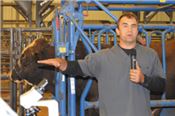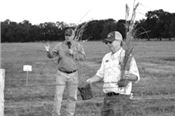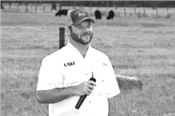|
Veterinarians Recommend Annual Bull SoundnessTests

Dr. Chris Thompson, a veterinarian in Pineville, talks about how a breeding soundness exam should be conducted on bulls before
breeding season. Thompson spoke at the cattle field day held Oct. 18 at the LSU AgCenter Dean Lee Research Station. He said bulls
should not be fed cotton byproducts, which could affect sperm production.
Photo by Karol Osborne/LSU AgCenter
ALEXANDRIA, LA.
A breeding soundness exam should be conducted annually on a bull, regardless of its past rate of successful breeding, an LSU AgCenter veterinarian advised at the sixth annual beef cattle and forage field day at the LSU AgCenter Dean Lee Research Station on Oct. 18 attended by more than 75 participants.
Dr. Christine Navarre said the $50 to $80 exam is well worth the expense, and the testing should be done early enough to allow time to find a replacement if a bull fails the test.
The exam involves more than a semen evaluation, she said. A complete physical exam by a veterinarian will determine if a bull is capable of successfully breeding a herd. Scrotal circumference is a key indicator of a bull’s potential, with a recommended measurement of 40 to 45 centimeters.
Bulls with low fertility are likely to pass that trait to offspring, including females, Navarre said.
Dr. Chris Thompson, a veterinarian in Pineville, said bulls should not be fed cotton byproducts, which could affect sperm production.
Both veterinarians urged cattle owners to obtain trichomoniasis tests on all new bulls. Cows can recover from the venereal disease, but bulls cannot, Thompson said.
The fight against parasites is becoming more difficult because of the limited options of dewormers. Some cattle are dying of diseases from the pests. “I haven’t seen that in 30 years,” Navarre said.
A veterinarian’s assistance with fecal sampling is needed to determine which dewormer to use and to determine if the product has been effective, she said.
Controlling parasites was once easy, and now many cattle herds lack natural resistance. Cattle owners will have no options if the current dewormers become ineffective because of resistance.
“There are no products in the pipeline that we know of,” Navarre said. “We’ve got to maintain what we have.”
Weaning calves is essential to enable cows to get back in shape and ready to breed again, said Jeff Gurie, livestock manager and research associate at the Dean Lee Research Station.
Calves should be vaccinated before weaning, Gurie said, and they should be dehorned and castrated as early as possible.
One option is to move calves away from their mothers, completely separated. An alternative is to keep calves with their mothers but use nose flaps on the calves to prevent nursing. A more preferred option is “fence line” weaning that uses a fence to separate calves and cows, Gurie said.
Studies have shown that fence line weaning is most effective and results in less stress and weight loss for calves, Gurie said.
Velpar is the best option for selective smutgrass control, said AgCenter weed specialist Ron Strahan. But he recommended checking the weather before an application. “We’ve got to get rain when we put it out,” he said.
Broomsedge thrives in soil with low fertility, and it can’t be killed selectively without killing the desired forage, he said.
Sendero works well on honey locust, and Chinese tallow trees can be killed with a mixture of three parts diesel and one part Remedy sprayed as a basal treatment, Strahan said.
In other field day presenters:
• AgCenter reproductive physiologist Glen Gentry covered different fencing configurations. If wood posts are used, he said, make sure they have been treated to prevent premature rotting.
• AgCenter entomology research associate Michael Becker said horn flies cost the U.S. cattle industry $1 billion a year due to control cost and economic damage from reduced milk production and weight loss. Studies show that cattle treated for horn flies on average weigh 14 pounds more than untreated cattle. Insecticides, including sprays, pour-on material and ear tags, provide control for horn flies, but he the same ear tags every year can also lead to resistance and loss of efficacy.
• AgCenter forage specialist Ed Twidwell said establishing bermudagrass pastures can be done more effectively with multiple cuttings at the rate of once a month. He said treating with a herbicide such as Facet when weeds are 2 to 3 inches tall at a cost of about $25 an acre will also improve bermudagrass growth.
• AgCenter entomologist Sebe Brown said armyworms are worse this year, possibly because the cold winter killed many of their natural enemies. The best time to scout for armyworms is in the morning or evening when worms are present on foliage. Pyrethroids or growth regulators such as Dimilin are economical control options that work well controlling fall armyworms in pastures and hayfields.
• AgCenter associate vice president Rogers Leonard talked about AgCenter restructuring, which includes agents who have been assigned specialties in horticulture, animal science, agronomy, forestry and wildlife. AgCenter ruminant nutritionist Guillermo Scaglia will have responsibilities throughout the state.
• Donna Morgan with the Louisiana Master Farmer Program said more opportunities to obtain Phase 1 training in LMFP will be available this year. ∆

LSU AgCenter weed scientist Ron Strahan, left, talks about products to control several pasture weeds while AgCenter forage specialist Ed Twidwell holds broomsedge, a weed that is an indicator of soil with low fertility. Strahan said using herbicides to kill broomsedge will also kill forage.
Photos by Karol Osborne/LSU AgCenter

LSU AgCenter entomology research associate Michael Becker says cattle owners who fail
to treat horn flies are losing money from reduced weight gains. He said several treatments are available.
|
|